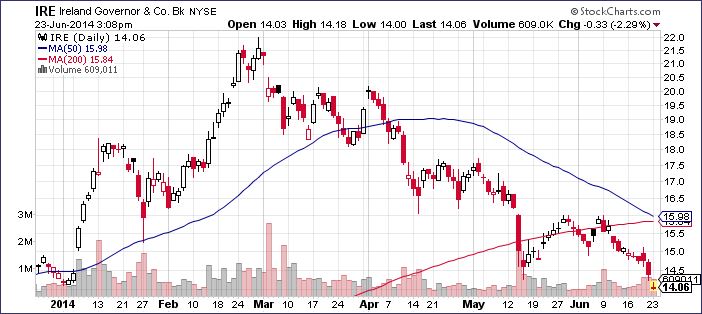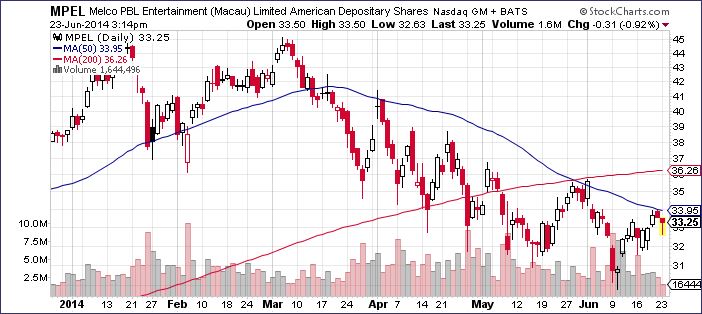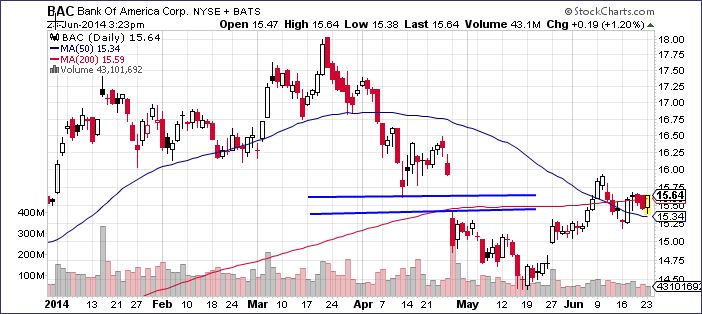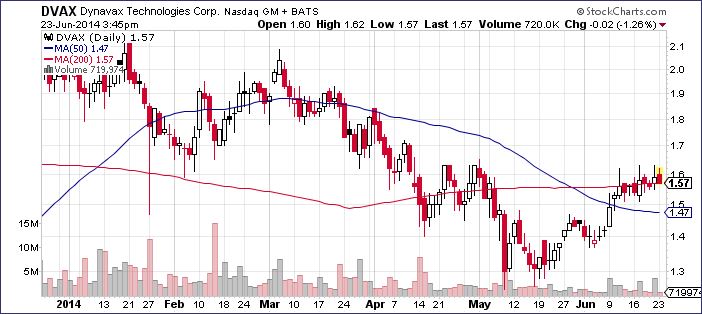Looks like the death cross club is about to get a new member:
What does it mean for IRE shareholders? Well, it’s certainly not good news, but it doesn’t necessarily mean that the future is totally bleak. Unfortunately, there are several more examples of recent death crosses in my portfolio, so here’s a quick update on how the other three stocks have been doing since their death cross dates.
Melco Crown Entertainment has done exactly what I predicted it would do a month ago. Since its death cross at the end of May, MPEL is down over 5%, and the near-term technical picture is looking just as bleak today as it did then. The test of resistance at around $35.50 failed, a new 6-month low of around $30 was put in, and another test of the 50-day SMA last week appears to have failed as well. Lower lows and lower highs looks like more waiting for MPEL shareholders in the foreseeable future.
From a technical analysis perspective, Bank of America is very interesting. First off, BAC is essentially flat since its death cross occurred a couple of weeks ago. After what appeared to be a breakout above the $15.50-$15.60 resistance level (reaching as high as $15.93), BAC pulled back to about $15.20 and has since been hovering right around the level where the death cross occurred. I noticed after the pullback that BAC had also closed a gap that formed during the “accounting error” fiasco a while back (the blue lines in the chart above). This gap is also in the same $15.50-$15.60 area, so there’s a lot going on here that is clouding the TA picture. Despite the uncertainty about BAC in the short term, I’m very optimistic about BAC in the long-term.
Dynavax is a great example of why IRE shareholders shouldn’t panic about this death cross. Since the cross, DVAX is up over 7.5% so far.
Technical analysis “rules” are far from perfect. So all the Bank of Ireland shareholders can take comfort in that DVAX chart. I’m not a day trader, and I’ve never made a trade based on technical analysis alone. Sometimes I use technical analysis as a tiebreaker between two stocks that are both appealing to me, but mostly look at charts for fun. Regardless of what IRE does after its imminent death cross, I’m glad I saw the writing on the wall and sold most of my shares a few months ago at $18.75. Now that IRE is down 25% from that level in four months, it appears to have been a pretty good call.
I want to take a minute to thank all the people that bought my book this past weekend while it was on sale. I hope you enjoy reading.
For everyone else: if the stock market seems random to you sometimes, trust me: it’s not. Want to learn how to understand why the market moves the way it does? Or maybe you just want to be able to look sophisticated in front of your coworkers when they ask you what you are reading on your Kindle, and you’d prefer to tell them “Oh, I’m just reading a book about stock market analysis,” rather than the usual “Oh, I’m just looking at pics of my ex-girlfriend on Facebook.” For these reasons and more, check out my book, Beating Wall Street with Common Sense. I don’t have a degree in finance; I have a degree in neuroscience. You don’t have to predict what stocks will do if you can predict what traders will do and be one step ahead of them. I made a 400% return in the stock market over five years using only basic principles of psychology and common sense. Beating Wall Street with Common Sense is now available on Amazon, and tradingcommonsense.com is always available on your local internet!





